 |
||
|
||
| ||
Computex 2006: Booth Of Compro Computex 2006: ASUS Serverboards Computex 2006: GIGABYTE Showcased Next Generation i-RAM (GC-RAMDISK) Computex 2006: GEIL And A-DATA Showcase DDR3 NVIDIA Introduces PureVideo HD Technology MSI Graphics Cards At Computex: Thermo-electric Cooling And Other Innovations Intel Says OK To Conroe-Based Notebooks Sony Enters D-SLR Market With New α DSLR-A100 SMART Modular Introduces Its First Dual-Channel DDR2 DIMMs And Mini-DIMMs Seagate Unveils 10 New Hard Drives Computex 2006: Booth Of Compro At Computex 2006 Compro introduced a wide range of new media products, including TV tuners, satellite receivers, etc. 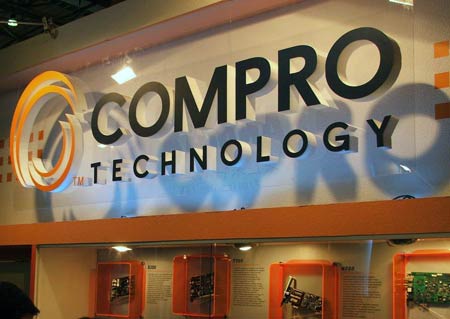  Company products were showcased on the background of earned awards:  Which include our award as well -- for DVB-T300 tuner: 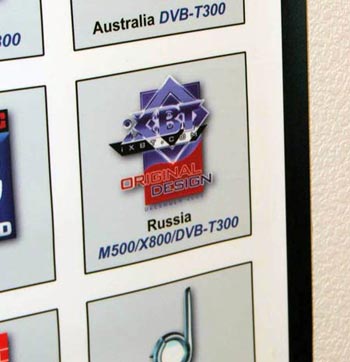 Special attention was paid to V550, DV850, U900, U3, U500, U890 models.  V550 specifications:
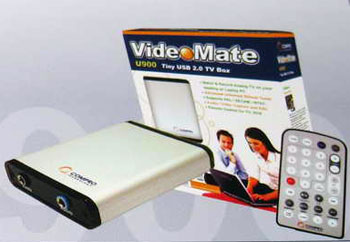 U900 specifications:
 For Windows MCE2005 the company designed the digital USB-stick DVB-T tuners: U500 and U3. These USB2.0 devices support EPG, subtitles and teletext, work with MPEG-2 video and receive digital radio. Computex 2006: ASUS Serverboards At Computex 2006 ASUS introduced a large number of server boards for both Intel, and AMD processors. Naturally they showcased the most actual solutions for Intel Xeon 5000/5100 and AMD Socket F. DSBV-D, a dual-way board for Intel Xeon 5000/5100, Intel Bensley (Intel 5000V). Supports up to 16GB FB-DIMM in 6 sockets. Dual Gigabit LAN:  A more powerful solution on Intel 5000P -- DSBF-D/SAS. Up to 32GB FB-DIMM on 8 sockets. 6 x SATAII and 2 x mini-SAS:  DSGC-D12/SAS (Intel 5000X) supports already 48GB in 12 sockets:  DSGC-DW is a dual-way workstation platform for Xeon 5000/5100 processors. Up to 32GB FB-DIMM:  M2N-LR -- a "spartan" solution for AMD AM2 based on NVIDIA MCP55-V Pro / Intel PXH-V chipset. Up to 4GB DDR2-533/667/800 in 4 sockets:  For AMD F processors ASUS presented the dual-way KFN4-DRE on nVidia nForce Pro 2200:  KFN4-D16/SAS on the same chipset, but with 16 memory sockets for up to 32GB:  And the KFN32-D SLI, a high-performance workstation solution on NVIDIA MCP55:  Source: iXBT
Besides thermo-electric cooling for graphics cards, at Computex 2006 MSI also introduced a number of other novelties worth a mention. The photo below shows an AMD Turion Mobile X2 based notebook MSI S271.  And the gaming notebooks on the same platform: M670 and M675 (nVidia C51 chipset, GeForce Go 7600 graphics):   There are also AMD AM2 boards, including the top-end MSI K9N SLI Platinum:  And of course the P965 Neo on Intel P965 (Broadwater):  The "first upgradeable graphics card" Geminium GO. It features two sockets for NVIDIA's MXM cards (intended for notebooks and barebones). The "daughtercards" are connected via SLI:  Finally the HDCP cards started to arrive. Only NVIDIA solutions for now:  The company showcased its new rackmount servers X2-106S3R and X2-106A2R based on Intel Bensley. They support Intel Xeon 50xx and Xeon 51xx (Woodcrest) processors and feature 12 x FB-DIMM sockets with total capacity of 48GB:  Intel is demonstrating its NAND flash based Robson technology at Computex Taipei 2006, with sampling to begin with notebook OEMs in August or September of this year, while the official launch will come once the Santa Rosa platform hits the market in early 2007, according to Intel Robson PME Mike Patterson. Robson utilizes NAND flash memory in conjunction with a standard hard disk drive (HDD) to create a Hybrid Hard Disk (HHD), which can improve software performance, reduce boot times and prolong battery life for a notebook PC by using features from Microsoft's upcoming Vista operating system. According to Patterson, Robson will come in 256MB, 512MB or 1GB options, and the NAND flash will be installed in notebooks either on a PCI Express (PCIe) micro card or embedded on the motherboard, although do to limited real estate most OEMs are expected to opt for an embedded solution. The solution will also include an ASIC and will require Intel's storage Matrix driver. Eventually, the support coming from the ASIC will migrate to the I/O controller hub (ICH), Patterson indicated.  Industry sources suggested that the ASIC supporting Robson should cost about US$5-6, and with 8Gbit NAND flash currently priced at about US$18, the total cost of Robson is already within the US$20 range. Intel will offer NAND flash for Robson through its IM Flash Technologies joint venture with Micron Technology, sources indicated. Robson will take advantage of two key features in Windows Vista – ReadyDrive and ReadyBoost. ReadyDrive enables the system to boot up faster by reading some files from NAND flash rather than from the hard drive. Patterson stated that the boot up time can be reduced from one minute to 30 seconds. ReadyBoost improves system performance by storing key software in NAND flash, which helps applications launch up to three times faster, according to Microsoft. Patterson added that Robson will utilize another Microsoft technology called SuperFetch, which monitors a user's software preferences and preloads the most used applications into the flash memory. Patterson estimated that about 176MB of the Robson solution will be devoted to ReadyDrive, while the rest can be used for maximizing application performance through ReadyBoost. Samsung Electronics is also working on a HHD, with its NAND flash solution coming in 128MB and 256MB densities. Samsung indicated it will also sample its HHD with customers beginning in the third quarter, while volume shipments will begin by January 2007, in conjunction with the Windows Vista rollout. Source: DigiTimes
Computex 2006: GIGABYTE Showcased Next Generation i-RAM (GC-RAMDISK) The "fastest storage device", GIGABYTE i-RAM, will be improved in the next generation showcased at Computex as a prototype. It will have a number of key differences, all of which are, frankly speaking, bound to be implemented:
 The development of the new GC-RAMDISK is not finished yet. The vendor plans it will arrive to the market in several months.
Computex 2006: GEIL And A-DATA Showcase DDR3 At Computex GEIL and A-DATA showcased the DDR3 memory. Despite the fact the first platforms using it should only be expected late in 2006 or in 2007, A-DATA declared its products would be available as soon as the need arises.  It turned out the company was using Nanya's chips in its modules. A-DATA's DDR3 memory featured latency of 7 which, according to the vendor, is to become the standard for the majority of such modules. The enthusiast memory is expected to have CL of 5. Higher clock rates should boost the performance decreased due to higher timings. The company showed 1333 MHz modules, promising 1666 MHz ones at some later time. A-DATA's modules lack heatsinks which have long been the de facto standard for the fast DDR2 memory. This makes us think of low energy consumption and heat dissipation. And is further proved by just 1.5V operating voltage.  GEIL showcased DDR3 1066 MHz and 1333 MHz, but didn't disclose any other information saying just that chips were not made by Nanya. Traditionally modules featured passive cooling that potentially promises higher clock rates.
NVIDIA Introduces PureVideo HD Technology NVIDIA today unveiled PureVideo HD technology, which delivers HD DVD and Blu-ray movie playback on PCs. PureVideo HD combines hardware acceleration from an NVIDIA graphics processing unit, high definition movie player integration and HDCP feature support to make it easy for manufacturers and consumers to build powerhouse PCs that can play HD DVD or Blu-ray movies. 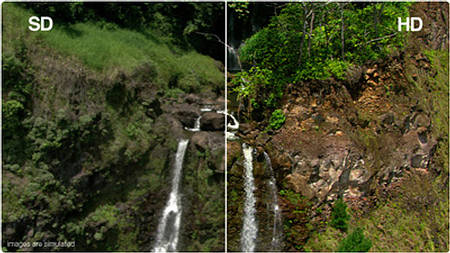 NVIDIA PureVideo HD technology provides:
A graphics card featuring PureVideo HD technology combined with an AACS HD disk drive, an HDCP-compliant display and a PureVideo-powered HD movie player from companies like CyberLink, InterVideo and Nero make it possible for consumers to enjoy superb HD movie playback on their PC. System builders including Sony, Toshiba and Acer have adopted NVIDIA GeForce GPUs with PureVideo HD technology to power their first PCs capable of playing Blu-ray and HD DVD movies. HD movie software from Nero, CyberLink and InterVideo fully supports PureVideo HD technology. Graphics card manufacturers including MSI and ASUS will release video cards this summer supporting all of the features of NVIDIA PureVideo HD. In addition, NVIDIA is working closely with major optical disk drive manufacturers including Sony/NEC, Panasonic, Pioneer, Toshiba/Samsung, and Philips to test disk drive performance and maximize compatibility. Source: NVIDIA
MSI Graphics Cards At Computex: Thermo-electric Cooling And Other Innovations The trend of implementing passive cooling onto low- and middle-end graphics cards has been obvious recently. There are several reasons, including stricter noise requirements and technological improvements (especially in case of NVIDIA's 90nm chips) further reducing heat dissipation. But, as said above, passive cooling was traditionally used in budget lower performance Radeon X1300, GeForce 7300, 7600GS cards, because of its mediocre efficiency.  MSI claimed it succeeded in developing a way more efficient passive cooling system. In includes a chip that monitors temperature and, when it exceeds 50°C, deviates it to a massive cooler via heat pipes.  No technical details on this 'Electric Thermal' solution were provided, but they claimed it could be used for the hottest cards. Though at the event they showcased the middle-end MSI RX1600XT Electric Thermal operating at 590MHz core and 1.38GHz memory clock rates.  MSI also demonstrated the Dual CoreCell technology in action. It can automatically increase and manage graphics card's voltage, clock rates and fan speed. Currently it's implemented into the new MSI RS1600Pro Diamond (450/800 MHz).  The trend of equipping cards with HDMI interfaces was also considered -- in RX1600XT-TD256E-HDMI and NX7300GS-TD256E-HDMI cards based on ATI and NVIDIA GPUs, respectively. Source: HKEPC
Intel Says OK To Conroe-Based Notebooks Intel does not rule out the possibility of seeing the adoption of its forthcoming desktop-use Conroe processors in notebook PCs, according to Jerry Kao, regional marketing manager for mobile products at Intel Taiwan. Kao made the remark at the sideline of the ongoing Computex Taipei 2006 IT trade show when asked whether Intel will be opposed to plans by some Taiwan notebook makers to try making notebooks based on the Conroe processor instead of Merom CPUs. Conroe processors are designed for desktops, while Merom CPUs are designed for use in notebooks Since Conroe and Merom both will come with a similar architecture, it is hard to rule out such a possibility, Kao explained. Kao noted that with a growing trend for slim and energy-efficient notebooks in the global market, notebook models built with desktop-use CPUs will be confined to certain market niche segments such as gaming, and the impact of such models on the mainstream notebook market would be insignificant. However, sources at Taiwan notebook makers pointed out that some notebook models are now available with a 17-inch or 19-inch display, and that those models would be attractive to performance-seeking game players or to those looking for a desktop replacement if the CPUs were switched to Conroe processors. Source: DigiTimes
Sony Enters D-SLR Market With New α DSLR-A100 Sony entered the digital single lens reflex (D-SLR) camera market with introduction of the α DSLR-A100 system. The novelty features a 10.2-megapixel APS CCD image sensor and will be introduced with 19 high-quality Sony lenses. It will also be compatible with most of the former Konica-Minolta Maxxum mount lenses. The system will include a wide range of accessories as well. Sony developed a new Dynamic Range Optimizer image analysis technology to provide improved picture quality and natural color reproduction, along with a new Bionz image processing engine. This new engine supports a continuous burst mode for fast-action shooting and performs intelligent power management. The DSLR-A100 camera features light sensitivity up to ISO 1600 and Super SteadyShot image stabilization, a Sony technology that shifts the image sensor to compensate for camera movement. Because Super SteadyShot is built into the camera body, all compatible telephoto, wide-angle, standard and macro lenses are automatically image-stabilized. This also allows from two to 3-1/2 stops of latitude in exposure, which supports hand-held shooting at longer shutter speeds than would otherwise be possible. The α DSLR-A100 is claimed to be the only D-SLR camera that can optimize dynamic range, meaning the range from highlights to shadows, including gain and contrast, through in-camera hardware processing. Sony’s Dynamic Range Optimizer (DRO) analyzes the captured image data and instantly determines the best exposure and color tonality of an image before JPEG compression. Unlike software optimization of a processed image, DRO is performed in the hardware. It is the first hardware-based DRO solution with the speed required for high-speed shooting. 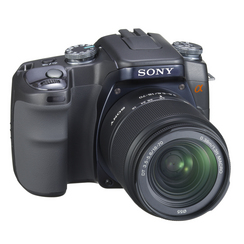 The camera will offer high-speed burst shooting at up to three frames per second continuously, at 10.2-megapixels and the finest JPEG compression. For those action shots, you’re limited only by the speed of your media card. The new camera will also have a long battery life. The supplied lithium ion battery gives you up to 750 shots per full charge, depending on usage patterns and environmental conditions. Speaking of dust removal, the camera’s CCD image sensor has an indium tin oxide coating to avoid static build-up so that dust does not readily adhere. Additionally, when you turn the camera on or off, an anti-dust feature is activated to literally shake off dust particles. Sony is continuing its long-standing relationship with Carl Zeiss to deliver new lenses for the α camera system. The two companies have co-developed three lenses, including an ultra-wide, 16-80 mm Vario-Sonnar T* zoom model and two fixed focal length telephoto models - a Planar T* 85 mm and Sonnar T* 135 mm. The system will also be supported with a full range of accessories, including a line-up of flashes, cable releases, rechargeable battery packs and several styles of carrying cases. The α camera also features eye-start auto focus, which starts focusing your picture before you even press the shutter; a 2.5-inch Clear Photo LCD Plus screen for wide-angle viewing and improved color reproduction; JPEG and RAW file format support; and a comfortable camera grip with easily-accessible function and mode dials. There is a slot for CompactFlash Type I/II and Microdrive media cards. The camera also accepts Memory Stick PRO and Memory Stick PRO Duo media cards through a supplied adaptor. The DSLR-A100 camera body will be available for about $900. The DSLR-A100K kit, which includes the camera body along with an 18-70mm zoom lens, will be available for about $1,000. Both will ship in July. Source: Sony
SMART Modular Introduces Its First Dual-Channel DDR2 DIMMs And Mini-DIMMs SMART Modular Technologies has launched new lines of dual-channel DDR2 DIMMs and Mini-DIMMs. Targeted at data networking and communications, storage, 3G wireless infrastructure, and high-density computing applications, these two new families of DDR2 modules may be configured as two 32-bit wide channels with seven bits of error correction code (ECC). Both lines of SMART's new DIMMs and Mini-DIMMs are optimized to be used with Broadcom’s quad-core 64-bit MIPS processor. Each 1GB module has two 512MB channels configured as 128Mx39 and allows simultaneous operation with each of the four SB-1 high-performance processors contained in the BCM1480. 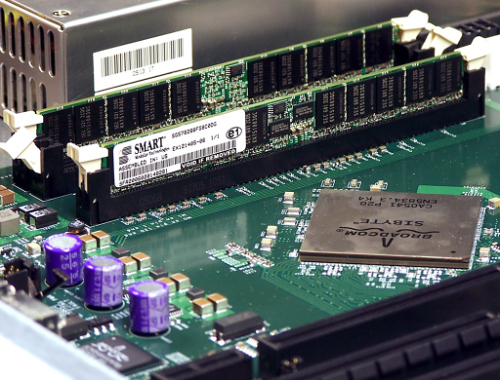 Combining the new SMART modules with the Broadcom processor helps achieve higher aggregate system performance for enterprise-class router and switches, high-end RAID system arrays, storage area networks, and high-density computing applications. The dual-channel modules enable the workload of the quad-core processor to be shared across multiple cores that rely on very high-speed interconnects and high bandwidth pipes to the memory and input/output. All four cores have access to the same shared pool of system resources, including memory and I/O. The memory controller on the BCM1480 interfaces with the ZBbus, supports DDR2-800 at up to 100 Gbits/s, and can be configured as four 32-bit channels. For applications that can distribute shared memory or coherent shared memory, support is provided to enable up to eight Broadcom chips (or 32 SB-1 CPU cores), each with separate channels of SMART memory, to communicate with each other over HyperTransport, as if they were all cores on a single chip. This feature enables the design of dense computing or processing clusters for performance scaling on a board or within a system. For maximum flexibility, SMART offers its dual-channel modules in two form factors. The VLP (Very Low Profile 0.72”) version is a 240-pin unbuffered ECC DIMM. The 244-pin Mini-DIMM has a height of 1.45” and allows for a maximum density of 2GB using 1Gb devices. Each module type can be matched with the vertical, angled, or horizontal connector type that is best suited for the application. The part numbers and specifications for the new dual-channel DIMMs are listed in the table below:  Source: SMART Modular Technologies
Seagate Unveils 10 New Hard Drives Seagate Technology announced a vast number of new hard drives and solutions for entertainment, consumer electronics, and computing. The company unveiled 10 new products, including 1.8-inch, 2.5-inch and 3.5-inch hard drives with up to 750GB of capacity for Consumer Electronics, notebook and desktop PC and enterprise applications. The company also introduced a notebook drive that combines rotating disc and flash memory, and added Macintosh support to its next generation Mirra personal server. The new consumer electronics products include Seagate ST18, LD25, DB35 Series drives. The Seagate ST18 Series drives leverage perpendicular recording technology to deliver 60GB per platter - all in a compact 1.8-inch disc drive. Designed for portable media players and GPS systems; digital video cameras and palmtop PCs, the drives feature G-Force Protection, a technology that increases robustness to 1500 Gs - comparable to solid-state memory. Sophisticated power management ensures longer battery life for handheld devices. The next generation LD25 Series drives are built specifically for game consoles, home entertainment devices and small footprint media PCs. Built with Seagate's DynaPlay technology, the drives provide media streaming, power consumption and content security, enhancing traditional gaming capabilities by allowing them to expand and create game soundtracks, rip and store entire libraries of music and video, and play multimedia. Currently available in 20GB, 30GB and 40GB capacities, the new LD25 Series drives will add 60GB and 80GB capacities. The DB35 Series hard drive, now available in up to 750GB, is designed to help manufacturers optimize HDD performance for high video capacities and other demanding DVR environments. DynaPlay Technology fine-tunes the drive's operating parameters for entertainment applications, including performance for uninterrupted digital media, security to enhance fair use of digital programming, and power to give manufacturers more leeway in selecting cost-efficient power supplies and keep internal temperatures under control. The DB35 Series drives are also based on perpendicular recording technology. Seagate's new branded solutions include the Seagate Mirra Sync and Share Personal Server and 8.0GB Pocket Drive. The Seagate Mirra Sync and Share Personal Server, the next generation of last year's Seagate Mirra Personal Server 2.0, is now available with Mac connectivity in 320GB and 500GB capacities. The server allows remote access to digital content from Internet and can be used to sync, share and protect data between PC and Mac computers in SOHO, small businesses and networked home environments. The Seagate Mirra Sync and Share Personal Server combines a suite of content protection features as well as free online user accounts allowing secure remote access and file sharing with family, friends and colleagues. Seagate is also announcing that two of its previously announced branded solution products, the 500GB and 300GB eSATA Pushbutton Back-up Hard Drives and the 750GB Pushbutton Back-up Hard Drive are now on retail shelves. Speaking of new PC drives, there are three Momentus family 2.5-inch notebook drives that are now available with perpendicular recording technology to deliver capacities of 160GB. The drives include the Momentus 5400 PSD, a 2.5-inch notebook hybrid hard drive that combines rotating disc storage with flash memory for greater power efficiency, faster boot-ups and increased reliability; the Momentus 5400.2 FDE, the 2.5-inch encrypting drive that delivers the highest levels of protection for data on lost, stolen or retired notebook PCs; and the Momentus 7200.2, a 7200-RPM drive for high-performance laptops. Seagate's enterprise offerings include new Barracuda ES and Savvio 10K.2 drives optimized for a variety of storage requirements for the enterprise. The new Barracuda ES packs the high capacity of 750GB, high reliability, and Enterprise multi-drive features demanded by capacity-intensive 24/7 applications. Seagate's second-generation 2.5-inch Savvio 10K.2 delivers high I/O transaction performance with 1.6 million hour MTBF reliability and up to 146GB capacity. Its ultra-low power consumption has dropped an average of 15% over its prior generation. The Seagate 320GB and 500GB Mirra Sync and Share Personal Servers will start shipping in June 2006 and will retail for $499 and $599, respectively. The Seagate 8.0GB Pocket Drive will begin shipping in July 2006 and will retail for $149. The Seagate 750GB Pushbutton Backup Hard Drive is currently shipping and retails for $559. The Seagate 300GB and 500GB eSATA Pushbutton Back-up Hard Drives are currently shipping and retail for $269 and $399 respectively. Source: Seagate Technology
Write a comment below. No registration needed!
|
Platform · Video · Multimedia · Mobile · Other || About us & Privacy policy · Twitter · Facebook Copyright © Byrds Research & Publishing, Ltd., 1997–2011. All rights reserved. |